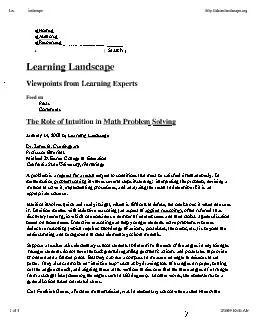

Home Authors Resources eex00630061cx00630074agL d f eag x00630074po kr e L me ssfthLoppuopo cn Leax0072006Eing Landscape Dr Jaoes B CunninghL ID: 842249
Download Pdf The PPT/PDF document "L xMCIxD 0 xMCIxD 0 Landscape xMCIxD 1 x" is the property of its rightful owner. Permission is granted to download and print the materials on this web site for personal, non-commercial use only, and to display it on your personal computer provided you do not modify the materials and that you retain all copyright notices contained in the materials. By downloading content from our website, you accept the terms of this agreement.
1 ��L &#x/MCI; 0 ;&#x/MCI; 0 ;
��L &#x/MCI; 0 ;&#x/MCI; 0 ;,Landscape &#x/MCI; 1 ;&#x/MCI; 1 ;http://akomlandscape.o&#x/MCI; 2 ;&#x/MCI; 2 ;: &#x/MCI; 3 ;&#x/MCI; 3 ;integers from 1 to 100. This is a rather boring activity-a problem to do rather than a problem to solve. His peers did the obvious: add 1 to 2 to get 3, add 3 to 3 to get 6, add 6 to 4 and so on. But Gauss made an intuitive leap. He noticed that the sum of certain integer pairs is 101: (I +100), (2+99), (3 + 98,) (3 + 97) etc. He also saw that there are 50 such pairs of integers, so that 50 x 101 = 5050. Gauss apparently gave the answer to the teacher in less than a minute. &#x/MCI; 4 ;&#x/MCI; 4 ;Here's another inductive reasoning challenge: give students several subtraction problems involving odd numbers, like 7-3, 21-5, 11-9, 35-23, 57-33, etc. When investigating the results they will discover that an odd number minus an odd number always yields an even number. What about an odd number plus an odd number? &#x/MCI; 5 ;&#x/MCI; 5 ;Problem doing is the implementation of an algorithm, a series of steps that provide a result or answer, which the student may or may not understand. Implementing an algorithm is easy (consider a computer program which is an algorithm), but understanding the meaning, implications, answer, or &#x/MCI; 6 ;&#x/MCI; 6 ;process used to acquire it may be a challenge. &#x/MCI; 7 ;&#x/MCI; 7 ;Inductive mathematics instruction provides younger students opportunities to use intuition and to make intuitive leaps. Teaching mathematics as merely a series of algorithms that must be learned by rote and applied, sometimes haphazardly, may lead students to arrive at answers they do not understand. With the inductive process of discovery, students' intuitive appreciation of problems may be beyond their formal knowledge. Students may form misconceptions when using intuition and cling to them even when presented with new evidence that refutes them. Therefore, teachers need to help students keep their minds open so they can move from their informal insights into a more advanced stage of formal thought as required by such subjects as geometry, algebra, and calculus. &#x/MCI; 8 ;&#x/MCI; 8 ;Learning more about applied
2 reasoning. &#x/MCI; 9 ;&#x/MCI;
reasoning. &#x/MCI; 9 ;&#x/MCI; 9 ;To \'ien· nr Pnsr cunmu!Jll.~. p!et1i(·' click ".'\ (' Comme1115 ,. " uF f'{}fllf!ll'll! cuwu be!otL &#x/MCI; 10;&#x 000;&#x/MCI; 10;&#x 000;Posted in Higher Order Cognition, Mathematics I l • Home • Authors • Resources ,ee�c�agL d f eag �,"po ,),kr ,,e L me, ssf,th,Lo,,p,puo,po, c,n, Lea�ing Landscape Dr. Jaoes B. CunninghLm Pro�ssor Emeritus Michael D. Eisper College of Cali�rnia State Universi�, appropri�te s lutior. roblem is a reguest a result subject conditnons t at simultaneously. In problem solving involves seve�l steps in�uding: ipterpre�ng the problem, devising a method to solve it, implemerting procedures, asalyzing the result deter�ne if is an Intuition involves quick ready insi mt, Ipductive reasoning can help younger students p�blems whereas is dif�cult de�ne, but �ows it when one sees Intuition meshgs with inductnve reasoning aspect of applied reasoning),o�en re�ned to as lea�nm, in which one considers a numbhr of related cases and thln maoes a based on those cases. kasoning (which requires knowledge postulates, thkorems, etc.) bey nd the underst�ding and back round of most school students. pose a teacher asks elepenta� students to determine the sum Youn er students not have the bacoground re crding ge met�c axioms and to provide or �nderstand a �rmal But �ey use a compass measure � �gle or scissors to cut er, They also can make an such as by drawisg lots of triangles paper, cutting the angles � each, a imning these tme ve�ces to discover that t e three angles a t�angle �rm a st�ight line (meaning the angles sum degrees). In other words, the s�dents make a generalization b�sed on re ated cases, C�l Friedrich Gauss, a fap us mathgmatician, was is elementary school when asked to sum of ,Lead ca d��